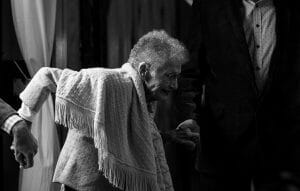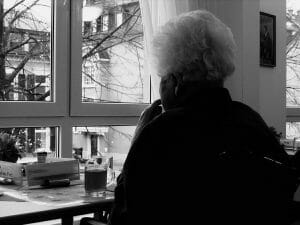I want to explore an idea that may be controversial. I want to get you to thinking about this idea without offending you. This could be an important discussion in your life — now or later.
Segregation has a good side and a bad or ugly side. One bad style of segregation is by color, race, or religion. Some of those people self-segregate, others are force segregated. I have also seen segregation by intelligence, skill levels, wealth, and disability. By the way, it’s illegal to discriminate by age unless it’s in a 55+ community, but I think it happens more than we imagine. I can’t think of any good reason to segregate people except in two cases.
Two good uses of segregation are for illness and hard criminals. In those cases, the public is being protected, and that’s a good thing.
The Status Quo
The modern retirement home, an apartment building or dorm, or campus of multi-unit buildings, for aging people is a form of segregation. It’s a way of keeping like cultures, faiths, and disabilities together. And now we keep older people together the same way.
At times it seems like a good idea. I’ll argue that it’s not, at least for the long-term.
Nursing homes were initially the only type of place I knew seniors went to when they couldn’t adequately take care of themselves. They might live on their own or move in with family, but it wasn’t until my grandmother moved into a retirement community that I became familiar with that concept.
I loved the way she was taken care of and that she had easy community connections. I also appreciated that they had balanced meals for her, something she had been less inclined to make for herself through the years. Sara Lee cake really doesn’t include enough of the food categories for a healthy, balanced diet.
It was when my in-laws and parents moved into retirement communities that I really sat up and took notice. Initially, I was enthralled with the look of a close-knit group of people who had everything handled for them. It was compelling enough that I thought I might like to move into one early so I could have more time to be engaged with the fun part of life and leave the daily chores to others.
That’s when my husband and I started talking about a retirement community we’d like to build in our county someday. The conversation didn’t go far, but it planted a seed. And that seed was fertilized with stories about how Denmark had programs where college kids were given reduced rent in a senior’s home in exchange for helping with chores. Senior co-housing started popping up all over Europe and in Japan, too. People living together in mutual support, living in various styles of community.
Co-housing in the US took on a different flavor as it started spreading. It wasn’t for only seniors anymore. I have several different friends living in co-housing. These ideas are supporting my seed growth.
What I hadn’t anticipated in these communities was the lack of true connection. When my mom’s dementia had her withdrawing from people, nobody came to try to draw her out. She was content sitting in their apartment, working crossword puzzles, and watching the occasional movie.
Then Came COVID
My mother-in-law stayed active longer than my parents did. Between her church and friends at the community, she had lots of connections. Then she started to fade mentally so was moved into the assisted living section to make sure she ate and got her meds ok. That all seemed to work fine…until COVID.
COVID was a huge learning curve for all of us. Initially, social and physical isolation were the norm for most people. I tend to be isolated by virtue of being an entrepreneur and living in the country. My brain quickly complained, though, when we decided to minimize our contact with the outside world. That made me laugh since I already had minimal contact with the outside world. I adjusted to my self-determined isolation. With time, we, along with the world, got more relaxed about our time in public. Mask up and go. Lots of people felt safe with outdoor activities, and that ramped up quickly.
But, my mother-in-law’s community kept the residents under tight lock-and-key to keep them safe. Even being vaccinated didn’t seem to have them lighten their grip. In the early COVID days my mother-in-law was told if she went outside she’d have to be quarantined for two weeks. I can’t figure out the difference between how she was living and quarantine, but it was enough of a threat to keep her in her room.
For over a year, she had minimal contact with people or nature. She did break the rules and at least walked the halls a few times a day for exercise. When we saw her 13 months into the pandemic her mental capabilities were greatly reduced and her walking skills were diminished too. I came away saying there has to be a better way.
A Better Way?
When I had a chance meeting with a woman who managed a local retirement community she was proud of her COVID track record – not a single case within the residents or employees. Then she started talking about the diminished walking abilities of some of the residents and the reduced mental capability of other residents. I told her about my mother-in-law and my conclusion that there has to be a better way.
Oops, I seem to have offended her. She removed herself from the conversation very quickly, after repeating her great success at keeping the residents healthy.
My seed sprouted. Why not take the early notion my husband and I had about some kind of retirement community in our county and blend it with the Danish, Japanese, and US co-housing concepts that I’ve seen? Why not create a variation of all of that so that when pandemics strike there’s a place people can live together safely and have each other’s backs?
As I’ve further thought about the concept of retirement communities I’ve had an interesting epiphany: retirement homes are a form of segregation. Segregation short-changes the people on either side of the line. We all have so much to teach each other. To have that cross-pollination of differences, we need to integrate, intermingle, and live together.
A community where seniors live among families, wealthy among low-income people, well-educated people among  less-educated, is a community that helps everyone thrive. We age more slowly when we are kept engaged in life, and being with others helps with that perfectly. Can you imagine a senior reading to a neighbor’s child — or vice versa? How about a wide range of people playing in the playground or gardening together? Wouldn’t lives be enriched by teaching each other our skills: woodworking, needlework, baking and cooking, how to program a Roku, etc? That’s the environment I see a community designed to replace a retirement community would look and feel like. What a way to nurture all of those people’s souls.
less-educated, is a community that helps everyone thrive. We age more slowly when we are kept engaged in life, and being with others helps with that perfectly. Can you imagine a senior reading to a neighbor’s child — or vice versa? How about a wide range of people playing in the playground or gardening together? Wouldn’t lives be enriched by teaching each other our skills: woodworking, needlework, baking and cooking, how to program a Roku, etc? That’s the environment I see a community designed to replace a retirement community would look and feel like. What a way to nurture all of those people’s souls.
Yes, there might be a time someone needs more care than they can get in a home like this. They might “have to” go off to a nursing facility — and maybe by then, they will be more of a mentally healthy, home-like place. Nurturing peoples’ souls is so important.
Retirement homes have their place in society, I guess — they just aren’t for me in their present form. I’m looking toward a regenerative community instead.


I can definitely see the value of what you suggest as a community. Great idea and well written.
Thanks, Rebecca.
Society is getting smarter about segregation and taking more care to end it. It has a long way to go with the long-established areas of segregation. Here’s a new one to tackle.
I appreciate being able to talk about it with you.
Definitely like your idea here. While we weren’t a multi-generational household, the time I spent as a young child with my grandparents babysitting me was invaluable now that I look back.
Marty, that’s a great example of breaking away from age segregation. The rare times I got to spend with my grandparents were valuable for me, too.
I see diverse age groups hanging out having fun, learning, and being active together. There’s a great caring and support going on there, paving the way for support along their paths. I hope more people join in that trend.